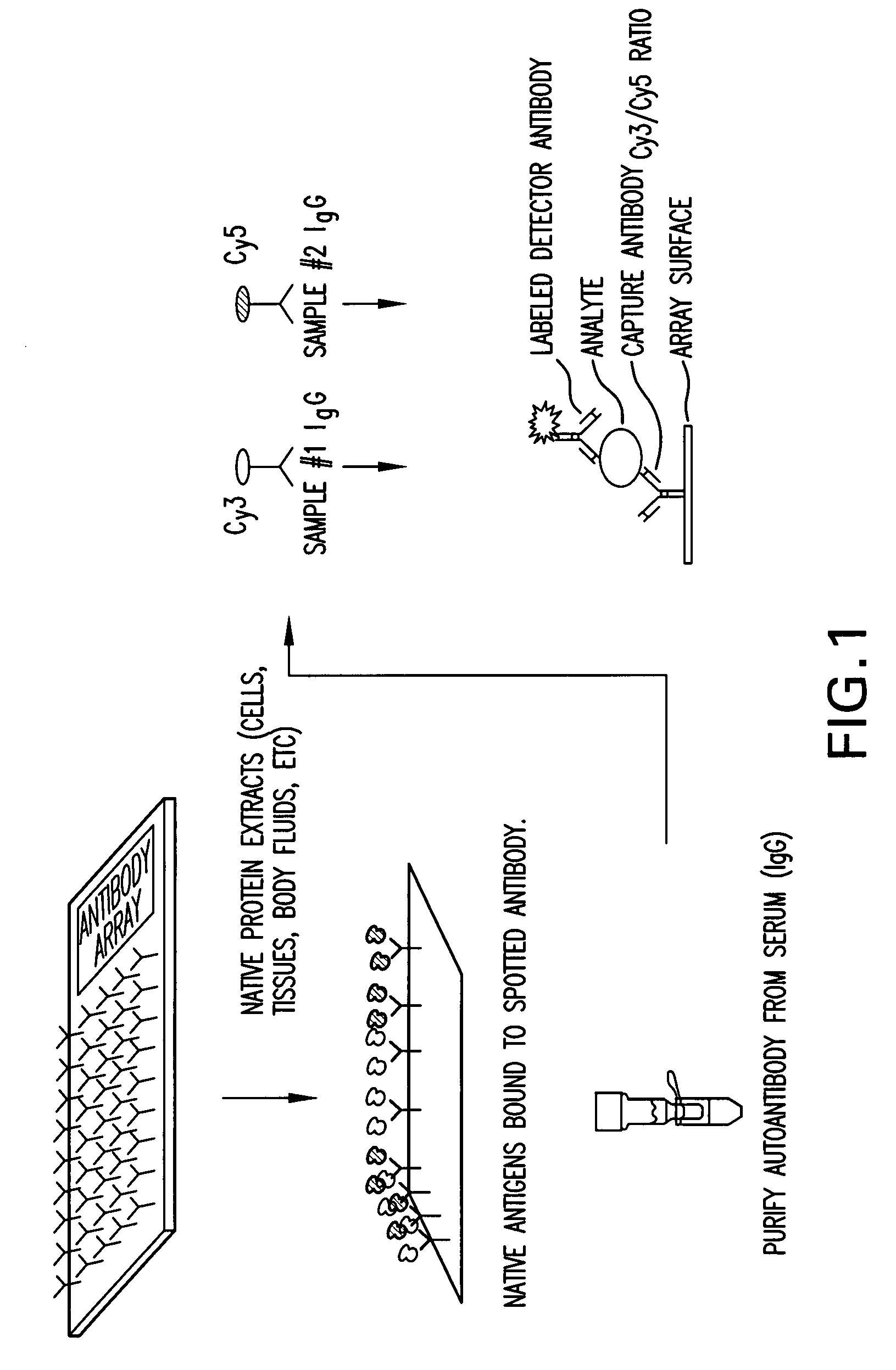Diagnostic serum antibody profiling
a serum antibody and profiling technology, applied in the field of diagnostic serum antibody profiling, can solve the problems of difficult to distinguish between men, adversely affect the quality of life, and fail to detect cancer in many men with early stage diseas
- Summary
- Abstract
- Description
- Claims
- Application Information
AI Technical Summary
Problems solved by technology
Method used
Image
Examples
example 1
Reverse Capture Microarray Assays
[0027]The present example describes the development and use of a “reverse capture” antigen microarray, which allows the antigens to be immobilized in their native configuration, and facilitates the detection of autoantibodies in sera from patients with cancer. The assay can be used, inter alia, to distinguish patients with prostate cancer from patients with benign prostate disease.
[0028]A. Materials and Methods
[0029]Clinical specimens: Serum specimens were collected from patients with prostate cancer or benign prostate hyperplasia using approved informed consent forms. For patients with prostate cancer, serum was drawn prior to radical prostatectomy. For patients with benign prostate hyperplasia, serum was obtained during normal office visits. The clinical characteristics of the patients for prostate cancer and BPH are listed in Tables 1 and 2.
[0030]Cell culture and lysis: Two established human prostate cancer cell lines were used. LNCaP (androgen re...
example 2
Differential Reactivity of Autoantibodies from Cancer and BPH Patients
[0045]Separate experiments were also performed in which serum from individual cancer patients was individually tested against pooled serum from BPH patients. (Note that in Example 1, both the sera of cancer patients and the sera of BPH patients were pooled prior to analysis.) This resulted in the identification of several additional markers (i.e., besides those in Table 3) which may be used to distinguish cancer patients from BPH patients (i.e., there is a greater elevation of autoantibodies to these antigens in cancer patients than in BPH patients).
[0046]Tables 4 and 5 present clinical data of the patients whose sera was used to determine significant antigens, i.e. antigens to which significant differential autoantibody reactivity among prostate cancer patients was determined, in a series of six experiments in which each individual prostate cancer patient's serum was tested for differential autoantibody reactivit...
example 3
Reverse Capture Microarray Assays for BPH
[0048]There have been some indications that BPH may induce detectable changes in serum antibodies (Anim, et al., Acta Histochem. 100(4):439-449 (1998); Nickel, et al., B. J. Urol. Int. 84(9):976-981 (1999); Di Silverio, et al. Eur. Urol. 43(2):164-175 (2003); Mahapokai, et al., Vet. Immunol. Immunopathol. 78(3-4):297-303 (2001); Prakash, et al., Proc. Nat'l Acad. Sci USA 99(11):7598-7603 (2002)). In the present example, the reverse capture microarray assay was used in an attempt to identify characteristic antigen-autoantibody reactivity in patients with this condition. The results suggest that the serum autoantibody repertoire from patients with BPH can be used to predict disease outcome. In addition, the identified antigens may serve to define aberrant cellular mechanisms for disease progression, and as potential targets for therapy and / or prevention (Tan, J. Clin. Invest. 108:1411-1415 (2001)).
Results and Discussion
[0049]Development and pro...
PUM
 Login to View More
Login to View More Abstract
Description
Claims
Application Information
 Login to View More
Login to View More - R&D Engineer
- R&D Manager
- IP Professional
- Industry Leading Data Capabilities
- Powerful AI technology
- Patent DNA Extraction
Browse by: Latest US Patents, China's latest patents, Technical Efficacy Thesaurus, Application Domain, Technology Topic, Popular Technical Reports.
© 2024 PatSnap. All rights reserved.Legal|Privacy policy|Modern Slavery Act Transparency Statement|Sitemap|About US| Contact US: help@patsnap.com








